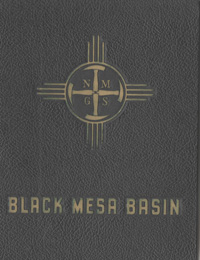New Mexico Geological Society
Fall Field Conference Guidebook - 9
Black Mesa Basin, Northeastern Arizona

Roger Y. Anderson and John W. Harshbarger, eds., 1958, 205 pages.
This ninth annual field conference is the first major excursion into the Black Mesa Basin. The conference is a joint venture between the New Mexico and Arizona societies. The first day, from Gallup to Holbrook, will reveal the structure of the Defiance uplift and monocline and the stratigraphy of the southeastern part of the basin. On the second day, from Holbrook to Flagstaff, the conference will enter the Black Mesa Basin and traverse volcanic fields, Pliocene lake beds, diatremes, and areas of ancient Indian cultures. On the third day, the conference will take a circuitous route through the San Francisco volcanic field to the Grand Canyon and reveal such features as Sunset Crater, the Cameron mining district, Marble Canyon, Glen Canyon, and the structural complexities along the western side of the basin. Finally an overnight trip into the Grand Canyon via the Kaibab Trail is available at the end of the third day.
Table of Contents:
Note —Downloads of the papers below are free. Road logs, mini-papers, and some other sections of recent guidebooks are only available in print.
Front Matter: (includes Dedication, President's Message, & Conference Organizer's Message)
Download (2.23 MB PDF)
Roadlogs: (each includes listed mini-papers)
— Edward C. Beaumont, pp. 12-21. https://doi.org/10.56577/FFC-9.12
— J. P. Akers and W. L. Chenoweth, pp. 23-34. https://doi.org/10.56577/FFC-9.23
— Maurice E. Cooley, pp. 35-37. https://doi.org/10.56577/FFC-9.35
— Maurice E. Cooley, pp. 40-45. https://doi.org/10.56577/FFC-9.40
— W. L. Chenoweth and J. P. Akers, pp. 45-53. https://doi.org/10.56577/FFC-9.45
— W. L. Chenoweth, pp. 54--56. https://doi.org/10.56577/FFC-9.54
— W. L. Chenoweth, pp. 56-61. https://doi.org/10.56577/FFC-9.56
Papers:
— Frederick S. Dellenbaugh, pp. 63-64. https://doi.org/10.56577/FFC-9.63
— John F. Lance, pp. 66-70. https://doi.org/10.56577/FFC-9.66
— Daniel S. Turner, pp. 71-73. https://doi.org/10.56577/FFC-9.71
— Kay Havenor and Willard D. Pyr, pp. 78-81. https://doi.org/10.56577/FFC-9.78
— H. Wesley Peirce, pp. 82-87. https://doi.org/10.56577/FFC-9.82
— J. P Akers, M. E. Cooley, and C. A. Repenning, pp. 88-94. https://doi.org/10.56577/FFC-9.88
— Charles G. Evensen, pp. 95-97. https://doi.org/10.56577/FFC-9.95
— John W. Harshbarger, C. A. Repenning, and J. H. Irwin, pp. 98-114. https://doi.org/10.56577/FFC-9.98
— H. G. Page and C. A. Repenning, pp. 115-122. https://doi.org/10.56577/FFC-9.115
— Charles A. Repenning, J. F. Lance, and J. H. Irwin, pp. 123-129. https://doi.org/10.56577/FFC-9.123
— Daniel S. Turner, pp. 130-135. https://doi.org/10.56577/FFC-9.130
— Vincent C. Kelley, pp. 136-145. https://doi.org/10.56577/FFC-9.136
— Maurice E. Cooley, pp. 146-149. https://doi.org/10.56577/FFC-9.146
— Robert P. Sharp, pp. 151-152. https://doi.org/10.56577/FFC-9.151
— Silas C. Brown and Robert E. Lauth, pp. 153-160. https://doi.org/10.56577/FFC-9.153
— Edward C. Beaumont, pp. 160. https://doi.org/10.56577/FFC-9.160
— Henry S. Birdseye, pp. 161-163. https://doi.org/10.56577/FFC-9.161
— Bollin, E. M. Kerr, Paul F., pp. 164-168. https://doi.org/10.56577/FFC-9.164
— R. B. O'Sullivan, pp. 169-171. https://doi.org/10.56577/FFC-9.169
— J. P. Akers and J. W. Harshbarger, pp. 172-183. https://doi.org/10.56577/FFC-9.172
— S. W. West, pp. 184-185. https://doi.org/10.56577/FFC-9.184
— Terah L. Smiley, pp. 186-190. https://doi.org/10.56577/FFC-9.186
— Robert L. Du Bois, pp. 191-193. https://doi.org/10.56577/FFC-9.191
— David A. Phoenix, pp. 194-196. https://doi.org/10.56577/FFC-9.194
— T. W. Cabeen, pp. 197-198. https://doi.org/10.56577/FFC-9.197
— Roger Y. Anderson, pp. 199-201. https://doi.org/10.56577/FFC-9.199
Recommended Guidebook Citation:
- Anderson, R. Y.; Harshbarger, J. W.; [eds.], 1958, Black Mesa Basin (Northeastern Arizona), New Mexico Geological Society, Guidebook, 9th Annual Field Conference, 205 pp. https://doi.org/10.56577/FFC-9